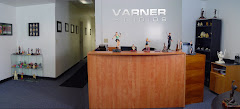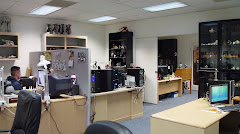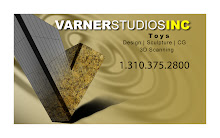Friday, November 11, 2011
Steinbichler 3D Scanner
Sunday, November 6, 2011
3D Scanners
This has led us to purchase a new Steinbichler Comet 5 white light scanner which has an accuracy to 5 microns. The Steinbichler captures detail perfectly and can be used for capturing geometric measurements in Auto and Aerospace industries where accuracy is absolutely critical.
The purchase of the Steinbichler Comet 5 has widened the scope of Varner Studios beyond sculpture and into more industries.
http://www.steinbichler.de/en/main/comet-5-eco.htm
Thursday, June 10, 2010
An Account Of The Complete History Of Action Figures by Varner Studios!
If we are to give an indepth accurate account of the history of action figures we must start from the beginning with the release of G.I Joe. It was released at its original 12” size in 1964 giving birth to the action figure business (even though I personally saw them as male dolls). G.I Joe was invented by Hasbro to try to tap into a market that would captivate boys much like what Mattel did to dazzle girls with Barbie. They believed that if they called the doll an “action figure” it would attract boys and generate an interest that would make them feel comfortable to play with G.I Joe, which essentially is a doll. So they trademarked the phrase “America’s Moveable Fighting Man” and even went as far as to display it prominently on the front of every package for G.I Joe. There were several points of articulation that at the time were not found on any other dolls. “G.I Joe was advertised as having 21 points of articulation. However, if one counts there are really only 19; head-to-neck, neck-to-torso, shoulder-to-torso (2), biceps-to-shoulder (2), elbow (2), wrist (2), torso-to-pelvis, hip ball-to-pelvis (2), thigh-to-pelvis (2), knee (2) and ankle (2). The figure was held together by means of elastic, wire hooks and metal rivets. Pivot pins were made of a ribbed plastic, which was pressed into the adjacent limb section, allowing the limbs to rotate as well as hinge at pivot point” - Wikipedia.
There was a doll for just about every line of defense such as Action Soldier, Action Sailor, Action Pilot and Action Marine, each with an overabundance of accessories from each branch. G.I .Joe had a successful 5 year run. However by the time the late 60s hit, the ongoing Vietnam War and overall anti-war mindset began to carry over into how the consumer viewed G.I Joe. (G.I. Joe is a nickname in reference to a man in the military; Government Issue Joe). With an atmosphere of love and peace in the air brought on by the 70’s G.I Joe had to find a new career. In 1969 G.I Joe became and an action adventurer. He was no longer being marketed as a military themed action figure but rather an adventurer marketed as “The Adventures of G.I Joe” This new line of G.I Joe included an Adventurer, American Ethnic Adventurer, Aquanaut and talking Astronaut. In addition, he also received life like hair and beard. Although Hasbro tried very hard to keep G.I Joe relevant in the changing world and market the new line did not do so well and by 1978 Joe was given and honorable discharge indefinitely.
The action figure business had its ups and downs through the 60s and 70s. One major event more than 10 years ahead of its time that would one day open up the flood gates and over saturate the action figure market was a 30 minute cartoon for the Hot Wheels. This was short lived due to a ban commissioned from the FCC. Here is an excerpt from an article written in 1986 by David Owens of (The Atlantic) regarding the FCC ban; “In 1969 Bernard Loomis and others at Mattel undertook what would eventually be seen as an epochal step in the marriage of toys and television. Mattel had introduced a line of miniature cars called Hot Wheels. Instead of simply advertising them on television, why not give them an entire show of their own? The thirty-minute Hot Wheels cartoon show joined ABC's Saturday-morning lineup. The show, developed in close collaboration with Mattel, featured cars from the Hot Wheels line. The new show didn't catch the attention of children only. It was also noticed by Topper Corporation, a now defunct competitor of Mattel's. Topper complained to the Federal Communications Commission that Hot Wheels violated FCC regulations concerning the separation of programming and advertising. The FCC agreed, and asked stations to log part of the show as advertising time—a move that seemed to deter the formation of any similar alliances between broadcasters and toy companies.” (Excerpt from “Where Toys Come From Selling; fun to children is one of capitalism's least predictable pursuits “ )
In 1976 Kenner launched Star Wars toys and merchandised it with incredible success. Bernard Loomis, President of Kenner Parker Products read a brief article about an up and coming movie called Star Wars. He had never even heard of the director but simply took a chance on the license because of the movie’s name; Star Wars. He sent the article to Kenner’s marketing group and asked them to look into it. They had exclusive rights to manufacture games, crafts and toys. The agreement did not cost much as there simply was not a competitive market at that time to make toys based on movies. Much to the chagrin of larger toy companies that turned down the license Star Wars proved to be a profitable gamble. For other toy companies like once giant Mego it marked the beginning of the end. Varner Studios, was given a few of the projects for Star Wars over the years for both Kenner and in later years Playmates. One contributing factor to the popularity of the Star Wars action figures was the size. Because of the oil crisis at the time the cost of plastic was on the rise. One way around the high plastic fees was to scale down the action figures to only 3 ¾ in. making the toys light weight and easy for kids to slip into their pockets and carry around.
It was not until 1978 when Loomis was approached by American Greetings to license a popular character known as Ziggy that the FCC ruling regarding kid’s shows would become something of a debate yet again for marketing toys or action figures. Bernard Loomis passed on the license for Ziggy because he felt Ziggy was already established as a comic strip character. He told the representatives for America Greetings that if they if ever had a project they wanted to partner up on from day one to come back. As it happened they had cards for an up and coming project set to be released the following year. Bernard flipped through the cards and saw a character of a little girl wearing a bonnet that he thought looked promising. He told the guys from American Greetings "Mark this time and date. We're going to make history." The little girl surrounded by strawberries with a bonnet was none other than Strawberry Shortcake. Marketing around the loveable character became essential in being able to sell a virtually unknown character. (Varner Studios actually sculpted a lot of the Strawberry Shortcake toys and Steve Varner created the Purple Pie Man for Kenner). In 1980 a show was released called “Welcome to the World of Strawberry Shortcake”. This was every bit a commercial as was the Hot Wheels cartoon. However the thinking in Washington had changed. There were a few organizations that tried in vain to get involved like ACT. However, the FCC ban was eventually overturned. By the mid 1980s television airwaves were filled with at least 20 children’s syndicated programs based on toy lines.
Hasbro eventually brought back G.I. Joe at the 3 ¾ size in 1982 after discontinuing the line in 1978. “When G.I. Joe resurfaced four years later, the line had shrunk (from just under a foot to just under four inches, a size made popular by star wars toys); changed its slogan (from "a fighting man from head to toe" to "a real American hero"), and multiplied itself into an anti-terrorist "strike force" consisting of sixteen separate characters (one of which was female and none of which was actually called G. I. Joe)” (Excerpt from “Where Toys Come From Selling; fun to children is one of capitalism's least predictable pursuits “- Written in 1986 by David Owens of (The Atlantic)
G.I. Joe was turned into a half an hour animated cartoon based on the toy line and the comic book series by Marvel Comics. It was first introduced as a two five part mini-series and later ran on syndication on a regular basis from 1985 to 1987. There were cartoons based on Wuzzles, Pound Puppies, GoBots, Snorks, Munchichis, She- Ra, Thundercats and M.A.S.K. etc… all of which had their own toy lines. The consumer’s market was over saturated with every kind of toy and action figure you can think of. This came with a high price to pay for those in the toy industry as well as retail shops whom were overstocked with action figures and experienced a rapid decline in sales.
As previously mentioned, in the mid 1980s the overall action figure market was spinning in a downward spiral towards being obsolete. Toy companies seemed to have lost their sense of creativity. They were grasping at anything to see what would stick. The market was over saturated with too many G.I. Joes to choose from and tons of Transformer rip offs to even name. Not to mention just about every 80’s cartoons such as Wildcats, Inhumanoids, C.O.P.S. and even WWF wrestlers were turned into action figures to be package and sold everywhere. (All of which were sculpted and turned into prototypes at one point or other by Varner Studios). In 1984 or so the market drastically declined after toys like He-Man were simply being reinvented and sold back into the market with no real change. The American consumer, especially mothers across the nation, were not being fooled into buying these toys.
A lot of things came about in the 80’s that affected the market negatively. It was an era of trendy fashions, Atari was all the rage, teeny- bopper movies invaded the theaters and MTV ruled the world. Hasbro realized the changing attitude of kids no longer growing up in “Leave It To Beaver” type homes and tried to grab hold of the slipping market by introducing a doll based on a character that had a rock n’ roll band. This doll’s name is Jem/Jerrica “A woman with a mysterious dual identity”. They tried to attract the trendy MTV market. Little girls no longer wanted to look like the wholesome Barbie dolls their mothers grew up playing with. They wanted to look like the pop stars they saw on MTV. Jem, had a mildly successful half hour cartoon called “Jem and The Holograms”. Jem mainly appealed to girls and although it had some “cool” male characters it was not enough for boys to embrace this all girl band concept. The Jem doll fell short of mass market appeal. The consumer simply lost interest in action figures and toys. It was time for something fresh to come out of the toy industry and revive it from near collapse.
In late 1986 Varner Studios was asked by the folks at Playmates Toys to sculpt their own version of the Teenage Mutant Ninja Turtles, based on the first comic book created, written, illustrated and produced by Kevin Eastman and Peter Laird. Playmates Toys had just purchased the licensing rights from the creators of the offbeat comic book. This was in the midst of the previously mentioned action figure market meltdown (many big shots in the toy industry thought action figures were on the verge of extinction). Playmates Toys took a huge risk on this unusual property mainly because they believed in this wacky new concept and story line. However they felt that the appearance of the Turtles themselves needed a better look to be accepted by the fickle public.
Enter Steve Varner who had a long history of doing just this very thing for many other toy companies. Steve took to task his own approach to sculpting these sewer dwelling terrapins. Although he only sculpted one in the beginning he started with a 4 inch tall clay which was sculpted primarily based on Steve’s intuition and imagination. When Steve was finished with his rough rendition of the first TMNT he brought it to Playmates for review and after some analysis and a few meetings Playmates and the comic book creators commended him as right on target. Varner Studios started the Turtle project towards the end of 1986. There was a goal to have a prototype painted and ready for display at NY Toyfair early February 1987. The deadline was fast approaching and with much to do and so little time the main focus around the studio became to get Donatello ready for his big debut. The studio had just enough time to quickly clean him up a bit in wax, cast him in urethane, paint him and ship him off to NY Toyfair. Donatello was to be displayed at the Playmates show room to see what kind of interest he would bring in as far as orders. This is where all the big chain store, toy buyers, go to review the new up and coming toy lines put out later in the year. The little Turtle was a hit! Ultimately, The Teenage Mutant Ninja Turtles allowed the market to believe in action figures again.
The TMNT story line put the characters in real time and not some alternate universe. The comic book characters spoke using, what was at the time, modern day lingo and street slang of the youth. They rode skateboards and their favorite food is pizza. The Turtles were easy to like and identify with. Every kid or teenager feels out of place at some point or other in their life. The Turtles were mutants and had no real place among humans. However, they found a home in the sewers of New York and were crime fighters trained in Ninjitsu by a mutant rat, Master Splinter. The Teenage Mutant Ninja Turtles characters were identifiable to kids all over the world because each Turtle was fully developed with their own characteristics, quirks and personality traits. Best of all, they had an appeal that attracted the attention of both boys and girls alike. This had all the makings of something with huge potential to market. (Boy! is that an understatement.)
Once back from NY Toyfair Varner studios set out creating all 4 original production Turtles in a large twice product size format. The 2 x format was the way most toy companies worked at that time since this was before digital methods were practical. This involved having an operator pantograph. This is a method that involves taking the prototype 2X model down by tracing over the entire form with a stylist connected thru a series of reduction gears to a milling machine cutter. This then cuts the product size mold out of a block of steel making the production tooling mold. Later Steve convinced Playmates to use what he thought was a more accurate and low cost cast tooling method. This eliminated the errors made by the pantograph operator and cast in steel which gave a more accurate representation of the final sculpt. This vastly improved the error ratio made on the vinyl parts such as the head, arms and legs. After the first 4 Turtles were finished they started from that point forward using the cast tooling method and sculpting all other characters for Playmates toys 106% up size accounting for the molding process shrinkage. This helped with not only efficiency, but also saving on cost and reducing the risk of unintended changes by the pantograph operator.
Varner Studios spent the next 15 years sculpting most of the Ninja Turtles Playmates Toys produced as well as some of the TMNT’s supporting characters. I hope you enjoyed this article on action figures and toys. Varner Studios has been a huge part of this industries growth and will continue on to future projects as it has behind scenes for over 30 years. They have worked with a lot of toy companies to help produce some of the greatest action figures thought up from those willing to imagine and invest. The rest as they say is history.
Wednesday, February 24, 2010
The Process
• Sculpt from scratch in house
• Receive scan data from the client.
• Receive 3D files through the client from the animation or video game development house. (we can use most all animation files)
• Scan in house with one of our five scanning methods
Traditional sculpting is something Steve Varner has been doing for over 30 years. Every Sculptor at Varner Studios has one way or other been mentored in traditional and digital sculpting for the fine art of toy making by Steve. There are a few steps involved in traditional hand sculpting.
• Start by making wire armature or skeleton of figure
• Build up clay over armature (clay can be soft so it moves quickly)
• Add articulation points so figure can move
(Clay is a soft material so fine detail isn’t possible)
• Mold figure
• Pour wax into mold
• Clean up figure in wax
(Wax is hard so precise detail is possible)
Specific safety requirements must be met to be safe for children. Varner Studios is familiar with all specifications required by the U.S and Europe for toys to be sold and safe for our children.
Digital Sculpting is done in a few digital programs we utilize in house. Sometimes we receive raw scan data from a client which we use to start the project as with a scan provided to us of Hayden Christensen as a younger Anakin Skywalker from an earlier Star Wars movie. Here at Varner Studios we use a number of different 3D programs integrated into our workflow based on the type of work to be done.
The raw scan of Hayden Christensen that was provide to us was an unrefined raw scan and we needed to make the scan work so we could utilize it as an older version of the actor for Star Wars III Revenge of the Sith.
In Freeform we cut away the hair, ears and eyes and worked on them separately. The features of the face needed considerable straightening and resculpting mostly in Freeform. The guys at Varner Studios later integrated the eyes and ears while they resculpted the hair in a different program. When the hair was finished they integrated it all in Freeform for final finish. They printed Anakin’s head on our Thermojet, then cleaned and molded the head. Thereafter they poured their special sculpting wax into the mold for final touch up. We molded the wax, poured urethane into the mold, and created a casting and painted it.
Friday, January 8, 2010
Do You Know Where Your Files Are! Not All Scuplting Studios Are Equal
The danger in this is with outsourced 3rd party involvment it is more difficult to keep the project confidential. This could leave an unreleased project more likely exposed to the competitors. Varner Studios offers a service that is truly a one stop in house shop. Varner Studios provides computer generated sculpture – using their own in-house scanners, state of the art rapid prototyping, in house computer sculpting arms and output machines, coupled with 30 years experience with traditional hand sculptures. Varner Studios is best known for producing accurate portraits and likenesses of famous people and characters. The ability to articulate anatomically correct figures without unsightly gaps and cuts is also one of our specialties. At Varner Studios, every single scanning, molding and output capability is in-house, eliminating the need for any third party 3D artists or studios. This allows us to work more efficiently and confidentially without any unnecessary file transfers.
When sculpting in a digital environment, we work in one of four basic ways
• Receive scan data from the client.
• Sculpt from scratch in house.
• Receive 3D files through the client from the animation or video game development house.
• We can use most all animation files; however, some can be time consuming when not water tight.
• Scan in house with one of our five scanning methods
Varner Studios offers printing of the final 3D model on their in house Objet (acrylic) and Thermojet (wax) 3D printers. Varner Studios has full knowledge and materials for all in house mold-making and painting projects. They take pride in actually doing everything themselves and being involved in all aspects of a project to ensure the clients confidentiality and satisfaction.
Tuesday, January 5, 2010
If You Don't Know The Name Varner Studios, Now You Will
If you want to check out Varner Studios please click on the below link:
http://varnerstudios.com/











